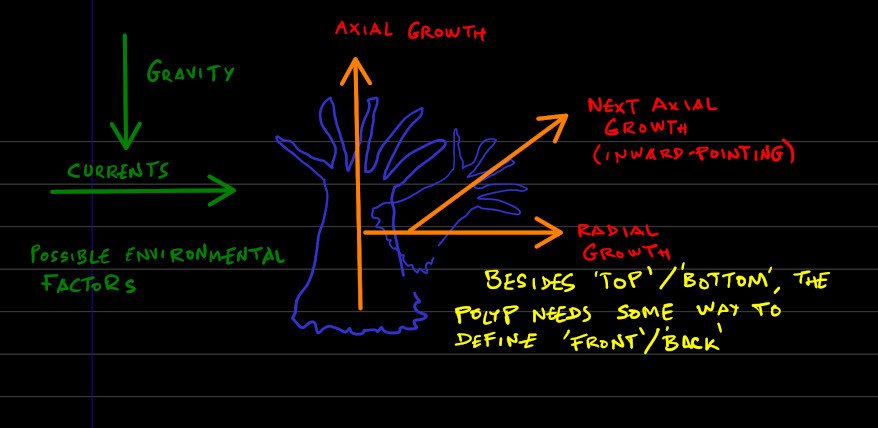
Everything posted by joigus
-
James Webb Telescope and L2 Orbit Question
Good call. I'm not sure. In the reference that @beecee provided, they say it requires relatively little thrust to keep it in orbit. If it's a very gentle saddle... What the technical reasons are, I don't know. Based on this, I'm assuming little fuel needs to be spent in order to keep it in orbit. The only thing I'm sure about at this point is that it's not going to be there forever.
-
James Webb Telescope and L2 Orbit Question
Maybe not a peak, but a saddle point. A saddle point would be unstable too. I studied this ages ago, and I don't remember. Wikipedia: It's as @beecee says. Apparently you need some thrust now and then to keep it in orbit.
-
Scientific establishments control over human evolution.
From 19.45 to 22.04: https://www.youtube.com/watch?v=r-L690pQhuo Here's a transcription of what Smolin says, *Does it matter that we let go of the attempt to pursue a concept of objective reality/objective truth. It's clear that's what Smolin is talking about if you rewind the video 30 seconds or so from where I've transcribed. It's very clear to me that Smolin is concerned that giving up on a concept of objective reality, when wielded by political minds, can turn into an excuse for 'everything goes'. It's nothing to do with elite scientists thwarting young, creative scientists when/if they're trying to push their ideas forward.
-
Wire Black Coral helix ?
But I did answer that part, I think, although implicitly. The key words are 'inward pointing' in my drawing. The new polyp would grow 'radially apart' from the parent one and continue describing an ever opening helix, because with every new 'generation', the plane shifts, as well as the radial distance with respect to the first 'ancestor'. The radius of that definite-chirality helix would increase more and more or less depending at a rate that depends on the ratio between the radius at which the offshoot buds and the angles (both with respect to that radius, and to the drawing's plane). I don't know if coral polyps can be grown in laboratory conditions. I suspect not. But if that could be done, it would be very interesting to set up a laboratory assay to test what environmental factors affect the growth pattern (by the way, I forgot prevalent direction of light, as corals are heavily dependent on it). I think it's a very interesting observation you made. I've scanned for different similar corals of the same family, and it seems to me that they all are right-handed helices. Edit: Sorry for the abundance of quotation marks, but I think you understand what I mean.
-
E.O. Wilson
Sorry, I looked for that in 'News' only. I should have done a look-up in the forums.
-
E.O. Wilson
https://www.theguardian.com/environment/2021/dec/27/edward-o-wilson-naturalist-modern-day-darwin-dies May a path of ants lead you to wherever there is light.
-
Wire Black Coral helix ?
Replacing 'left' by 'tangential' doesn't exactly clinch the case, IMO. There is a clockwise tangential, and an anti-clockwise tangential. But I think you touched a very important point that for some reason you don't recognise as having a molecular basis (homeobox genes, which are what determines developmental hormones, which in turn determine relative placement of organs, cells, etc.): It's the pattern with which the next polyp buds out of the progenitor polyp. As far as I can see, you need another plane of assymmetry to complement the axis defined by the growth, and always keep it 'doing the same thing', so to speak. The simplest hypothesis that would explain the appearance of this plane of 'slight asymmetry' is how growth hormones flow away from one side of that plane and onto the other. Environmental factors cannot be excluded, of course (See image below.) Plants always grow their stems towards the Sun and their roots towards the ground due to combination of growth hormones + light, gravity, etc. Consider a spherically symmetric phase of the embryo previous to the blastocyst (the first 'axial' phase.) There's no up, no down, no front, no back, no left, no right. After that stage, a migration of subsequent-generation stem cells has to decide what's up and what's down (blastocyst). 'Up' and 'down' don't mean anything in themselves. It's cellular development that decides that. And who decides these placements? Hormones do. You've got an equivalent to your polyps here, because the organism is cilindrically symmetric. Next, stem cells of another generation have to decide what's front and rear. A second axis, perpendicular to the first, defines this, forming a plane with the previous one. Migration is induced with respect to this plane. Now the fact that you've defined two perpendicular directions, in 3-dimensional space, automatically determines the third. This is a peculiarity of 3 dimensions. What is right and what is left is only possible because we've agreed first what's up and down, front and rear. The curious aspect of these corals seems to be that chirality is minimally and elegantly defined, not having to do with migration of specialised tissue, and resembling very much the (minimal) mathematical definition. Why it's fixed once an ancestor organism evolved it that way I think boils down to macromolecules, the very same reason why our liver is on the right, and our children's liver is also on the right. These orientation factors rarely ever change once they've been decided.
-
Wire Black Coral helix ?
It's the mirror image of the picture you attached... Picture a human as a perfect cilinder. Now picture an arm growing from somewhere. The human says: 'This is my right arm' Well she may say so, but something's not right. And yes, I'm right.
-
Wire Black Coral helix ?
The problem is: In other words, you said the polyps are cilindrically-symmetric. In that case, whatever you call the left, turn around 180 degrees and, voila, it's the right.
-
Wire Black Coral helix ?
The problem I see with crowding effects is that one way or the other (one chirality or the other) makes no difference to the effects of getting tangled, as long as all the individuals (colonies or whatever) become helical in the same way. If that were the case, we would see left-handed colonies as often as right-handed ones. Also with eddies and currents playing a role, I would expect to see regional differences. All this, of course, taking at face value: The effect you propose is not to be ignored in many cases. There are mossy plants in New Zealand that grow to exactly the same height, so as to form a collaborative pad that's useful to protect the whole community against frost. Any plant that grows above that is penalised, because it losses protection. With chirality though, it's either this way or the other, --a binary menu of possibilities, shall we say-- which suggests to me a developmental mechanism based on molecular grounds. I'm not sure though, and I wish this OP gets the contribution of experts ASAP. x-posted with @Genady That's interesting. I can't find this information on the web. Can you give me a pointer to that, please?
-
Wire Black Coral helix ?
Your assumption No. 1 is a must; otherwise there's no way you can correlate internal chirality with overall growth pattern that displays chirality. It stands to reason. Your assumption No. 2 I don't see as necessary. If you can tell your head from your feet, and your liver-side from your non-liver-side, it's child's play to write an instruction (internal) in your memory that says: If your neighbour is to your left, hold hands and bend this way. Minimize interference is not necessary. In fact, you must interact and correlate. The important thing is to correlate how you bend, how your neighbour bends, and what side you face to them --I think. You can 'amplify' chirality any way you want with these prescriptions --I think.
-
Wire Black Coral helix ?
Whether something is a colony or not is not a clearcut biologycal category in my opinion. Endosymbiosis* changed that picture, and while we still talk about "organisms", the distinction is blurry at best. Kelp is a multicellular protist. Eukaryotes have plastids (genetically-independent inclusions). I consider myself a colony that includes intestinal bacteria, my mom's mitocondria, etc. Yet my liver is on the right because my homeobox genes ordered developmental hormones that made my stem cells put it there. *Among other things. 'My liver is on the right' is chirality, not of such sublime beauty as an helical coral. But chirality it is, and monitored by homeobox genes.
-
Wire Black Coral helix ?
Take some time to read about homeobox genes and your difficulties will ease considerably. As I said, I'm not an expert, but I do remember development of organism spatial patterns is heavily monitored by homeobox genes and decides what's up, and down, left, or right, where your liver is, and such. Symmetry is also determined by this package of genes, AFAIR.
-
Wire Black Coral helix ?
Thank you. Yes it does apply to tartaric acid and a bunch of sugars, including glucose. Google for "stereoisomers of" and whatever compound you're interested in and you'll get the physico-chemical information. As to the relevance in biology, I don't know. I hope some experts can illuminate aspects of it at least. I'm not one. Whether it's an effect due to the currents, it could be for all I know, if eddies tend to form with a particular chirality, which they do. A Coriolis effect, as you suggest, is possible. Maybe @Genady is also a traveller, and can provide more information. I somehow find it hard to believe that the calcium carbonate scheletons of corals could be shaped by local eddies, but let's see what others think. Interestingly enough, I've googled for "chirality and corals" and I've found that some calcium carbonate coral scheletons are affected by chirality: https://www.nature.com/articles/ncomms15066 Corals and chirality seems to be an active field of research, judging by Google Scholar's search results. Most of what I've seen is targeted at a molecular level.
-
Wire Black Coral helix ?
Look up the words "chirality in Nature" and you'll find more wonderful examples of this. Chirality is the property of being distinguishable from your mirror image. https://en.wikipedia.org/wiki/Chirality I don't know whether it's related, but for most proteins, only one chiral version is present in Nature, at least in this part of the galaxy. The left-handed version is here, but the right-handed version is not, or is biologically irrelevant.
-
Dark matter
As Swansont is trying to tell you, the sphere is only for calculational purposes. There's no spherical symmetry. You place a sphere like that any place you want in the universe and calculate acceleration as due to the effect of gravitational attraction from all mass contained in that sphere. Resulting acceleration (which is an overall property of the whole universe) can be positive, negative, or zero, depending on relation between mass density and acceleration parameter, similar to escape velocity possible situations. Susskind makes that very clear in those lectures, as far as I can remember. It may be a bit puzzling that you can get the result from a calculation that involves an imaginary sphere, but that's the magic of Newton's theorem. It's not a sphere that's causing that acceleration. Or, perhaps, if you like a sphere of infinite radius of which any other sphere is at its centre.
-
Dinosaur Egg Impresses Scientists
I also think it's impressive, perhaps tantalising. But no paradigm seems to have been overturned. It seems that the most important surprise factor comes from the good state of preservation, rather than it beeing completely unexpected. I wouldn't be surprised either if new discoveries converge to a picture in which some of what we think to be 'modern features' actually arose much farther back, which seems to be the direction this finding is going.
-
James Webb telescope to launch today
Yeah. Most of those failure points will be relevant during deployment. And a big part has to do with operating the Sun shield. The telescope must work at 6K on average, and it seems that the most difficult part was to guarantee that this gravitating laboratory cools down to the required level. It's a matter of months. We've got some more waiting to do.
-
James Webb telescope to launch today
LOL. I meant, it's a ho, ho, ho.
-
James Webb telescope to launch today
Weather is OK. It's a go. https://www.bbc.com/news/science-environment-59782057 Live:
-
Dark matter
Here it is: What's appealing about this line of thinking is that it proposes to combine well-known principles of physics in unexpected ways, rather than guess unexpected principles of physics in well-known ways. The first technique has always met much more success than the second.
-
Dark matter
At smaller scales dark matter doesn't really play that much of a role. It's when you get to the region of galactic haloes when it starts to kick in. That's why you don't consider it when solving problems like, eg., the perihelion of Mercury. It's very sparse and apparently nucleates around the galaxies, but at very long distances in comparison with atomic matter. As there are no collisions, it doesn't fall anywhere near the galactic centres in any significant amount. Einstein's equations OTOH seem to me to be formulated as some kind of compromise --a brilliant and predictive one to be sure. The Einstein tensor does not saturate all the possible geometric degrees of freedom. The other degrees of freedom are coded in the Weyl tensor. They can also be generalised in several ways, like including torsion, complexifying them... They seem so inviting for generalisation. Although this is nothing but a hunch. It also has to be said that the attempts have been many, and nobody so far seems to have been able to extend Einstein's predictions significantly. As to primordial BHs, it's very appealing. But how big can they grow before there would be noticeable effects? I don't think you mean dark matter haloes are made up of SMBHs. We would have seen them already by their lensing effects. Plus the masses would be so out there. I'm probably just expressing my preferences. We really need the data James Webb will provide.
-
Do angels have wings ? Were they created with wings ? Or an illusion people saw ?
I trust any third-rate archaeologist of the 21st century a thousandfold more than an army of thirty thousand Maimonides. Maimonides hadn't the faintest idea what carbon dating was about, or what the Hebrew pastoral and agricultural people of the Bronze Age had to deal with on a daily basis --because he didn't dig the ground in search of refuse food, or ancient manuscripts, or even excrements.--, or what the layers of destruction of ancient cities looked like. A city like Meggido was destroyed thousands of years before Maimonides was born, and yet, archaeologists of the 21st century have seen, sifted through, and analysed to the minutest details every inch of terrain in that city and many others like it, and consequently are much more intimate with what those people thought, their dreams, their hopes, their fantasies, than Maimonides would have even dreamt of.
-
Dark Matter:
How do we know this?
-
Dark matter
OK. I changed my mind: 1) Really a signal that Einstein's equations must be modified at long distances 2) Exotic particles coming from super-symmetric extensions of the standard model of elementary particles 3) Swarms of little black holes (that for some reason do not evaporate)


